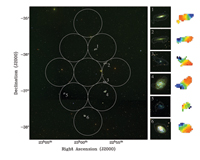Steerable beams create flexible 'footprints'
|
Left: An observation of the galaxy group IC 1459, |
September 2014
The Boolardy Engineering Test Array (BETA) òÀÓ the first six ASKAP antennas installed with Mk I phased array feed receivers òÀÓ is already a functioning telescope, and allowing the commissioning team to gain a deeper understanding of the methods required to maximise the science capability of ASKAP.
The primary benefit of the ASKAP phased array feed (PAF) is a rapid survey speed facilitated by a wide field-of-view, and the ability to form multiple synthetic beams with each receiver.
Key to the flexibility of the PAF is the ability to choose a òÀØfootprintòÀÙ òÀÔ a specific arrangement of the beams òÀÔ based on the object or region of the sky being observed.
The BETA system supports the formation of nine synthetic beams on each antenna, and allows the team to test various beamforming techniques in order to gain a deeper understanding of beam stability, ensure good sensitivity and high dynamic range during commissioning activities.
Different beam footprints, including a 'standard' cluster pattern as well as a straight line, have already been used to demonstrate early science capabilities with BETA.
More recently, BETA was used to image HI in the galaxy group IC 1459, at a distance of ~30 Mpc. A diamond shaped beam footprint òÀÔ with the long axis oriented north-to-south òÀÔ was chosen to maximise the number of HI detections. This group hosts numerous galaxies and is an ideal target for studying galaxy evolution in dense environments.
Six galaxies were detected in this observation; in the main image, the white contours show HI with a surface density of ~1 solar mass per square parsec. The smaller panels on the right zoom in on each of the six detections and show that the HI and its rotation are well resolved.
While the imaging capabilities of the six-antenna BETA system are still limited compared to those of the final ASKAP, the instrument provides an important testbed for the team to optimise beamforming methods, and provides the team an opportunity to prepare
Dave McConnell, leader of the ASKAP Commissioning and Early Science team, notes that the introduction of phased array feeds and digital beamformers to a radio telescope provide a huge step in the technical armoury of the radio astronomer.
"It gives the astronomers choice in their selection of the most appropriate primary beam and field of view in their observation,òÀÝ says Dave, òÀÜIn the future, ASKAP will allow beams to be optimised for shape, sensitvities, polarisation purity and even immunity to RFI. No such choice is currently available with convential telescopes equipped with wave-guide feed horns.òÀÝ
ˆà
Back to Latest ASKAP News page.

